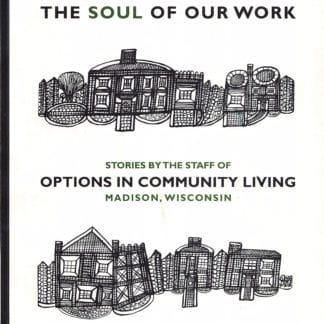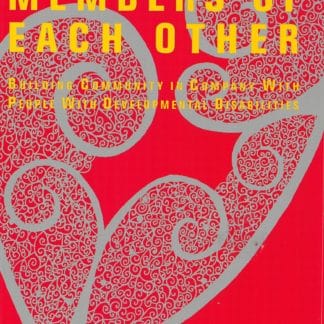by John O’Brien, Marsha Forest, Jack Pearpoint, Shafik Asante & Judith Snow
The Ethics of Inclusion: Three Common Delusions
by John O’Brien, Marsha Forest, Jack Pearpoint, Shafik Asante & Judith Snow
We want to begin a dialogue on the expectations about personal behavior that go along with a commitment to Inclusion. Unattainable expectations confuse good people and fragment efforts for change into factions organized around hurt feelings. We who care about Inclusion can reduce this drain on the energy necessary to work for justice by being clear about three delusions which are common, but mostly unconscious among advocates for Inclusion. When we replace these false and destructive beliefs with simpler expectations of decency and working constructively in common, we will all be better able to live out the real meaning of Inclusion by honoring and growing from our shared struggle with our diverse gifts, differences, and weaknesses.
[In writing this article, we have struggled for clarity. We talked about whether to use “delusion” or “illusion”. Delusion means “a mistaken idea or belief”. Illusion a ‘false appearance or deceptive impression of reality”. They are synonyms – but we have chosen “delusion” because it is stronger.]
Delusion 1
Inclusion means that everybody must love everybody else or “We must all be one big, happy family!” (OBHF) This delusion is at work when people who care about Inclusion feel shocked and offended to discover that other Inclusion advocates don’t really like one another. Sometimes this delusion pushes people into pretending, or wanting others to pretend, that real differences of opinion and personality don’t exist or don’t really matter. The roots of this delusion may be in a desire to make up for painful experiences by finally becoming part of “one big happy family,” (OBHF) where there is continual harmony and peace. The “one big happy family” (OBHF) delusion is the exact opposite of Inclusion. The real challenge of Inclusion is to find common cause for important work that cannot be done effectively if we isolate ourselves from one another along the many differences of race, culture, nationality, gender, class, ability, and personality that truly do divide us. Educating our children is one such common task. The reward of Inclusion comes in the harvest of creative action and new understanding that follows the hard work of finding common ground and tilling it by confronting and finding creative ways through real differences.
The “one big happy family” (OBHF) delusion destroys the possibilities for Inclusion in a complex community by seducing people into burying differences by denying their significance or even their existence. People in schools or agencies or associations which promote this delusion lose vividness and energy because they have to swallow the feelings of dislike and conflict they experience and deny the differences they see and hear. Denial makes a sandy foundation for inclusive schools and communities. Community grows when people honor a commitment to laugh, shout, cry, argue, sing, and scream with, and at, one another without destroying one another or the earth in the process. We can’t ever honestly celebrate diversity if we pretend to bring in the harvest before we have tilled the ground together.
Delusion 2
Inclusion means everyone must always be happy and satisfied or “Inclusion cures all ills.” A group of good people came together to study inclusive community in an intensive course. One person, Anne, angrily announced her dissatisfaction from the group’s first meeting on. She acted hostile to everyone else and to the group’s common project.
At first, the group organized itself around Anne’s dissatisfaction. A number of members anguished over her participation. It was hard for the group to sustain attention on anything for very long before the topic of how to satisfy Anne took over. The group acted as if it could not include Anne unless she was happy. And, they assumed, if they could not be an inclusive group (that is, make Anne happy) they would be failing to live up to their values. Two other members dropped out the group, frustrated by their inability to overcome the power of this delusion and move on to issues of concern to them.
The group broke through when they recognized that true community includes people who are angry and anguished as well as those who are happy and satisfied. After overcoming the delusion of cure, the group gave Anne room to be angry and dissatisfied without being the focus of the whole group. Let out of the center of the group’s concern, Anne found solidarity with several other members, whom she chose as a support circle for herself. In this circle of support her real pain emerged as she told her story of being an abused child and a beaten wife. She did not go home cured or happy, but she did find real support and direction for dealing with the issues in her life.
The delusion that Inclusion equals happiness leads to its opposite: a pseudo-community in which people who are disagreeable or suffering have no place unless the group has the magic to cure them. Groups trapped in this delusion hold up a false kind of status difference that values people who act happy more than people who suffer. This delusion creates disappointment that Inclusion is not the panacea.
Real community members get over the wish for a cure-all and look for ways to focus on promoting one another’s gifts and capacities in the service of justice. They support, and often must endure, one another’s weaknesses by learning ways to forgive, to reconcile, and to rediscover shared purpose. Out of this hard work comes a measure of healing.
Delusion 3
Inclusion is the same as friendship or “We are really all the same”
Friendship grows mysteriously between people as a mutual gift. It shouldn’t be assumed and it can’t be legislated. But people can choose to work for inclusive schools and communities, and schools and agencies and associations can carefully build up norms and customs that communicate the expectation that people will work hard to recognize, honor, and find common cause for action in their differences.
This hard work includes embracing dissent and disagreement and sometimes even outright dislike of one person for another. The question at the root of Inclusion is not “Can’t we be friends?” but, in Rodney King’s hard won words, “Can we all just learn to get along – to live with one another?” We can’t get along if we simply avoid others who are different and include only those with who we feel comfortable and similar. Once we openly recognize difference, we can begin to look for something worth working together to do. Once we begin working together, conflicts and difficulties will teach us more about our differences. If we can face and explore them our actions and our mutual understanding will be enriched and strengthened. To carry out this work, our standard must be stronger than the friendly feelings that come from being with someone we think likes and is like us. To understand and grow through including difference we must risk the comfortable feeling of being just like each other. The question that can guide us in the search for better understanding through shared action is not “Do we like each other?” but “Can we live with each other?” We can discover things worth our joint effort even if we seem strange to one another, even if we dislike one another, and it is through this working together that we can learn to get along.
The delusion of sameness leads away from the values of Inclusion. It blurs differences and covers over discomfort and the sense of strangeness or even threat that goes with confronting actual human differences. Strangely, it only when the assumption of friendship fades away that the space opens up for friendship to flower.
An ethic of decency and common labor Inclusion doesn’t call on us to live in a fairy tale. It doesn’t require that we begin with a new kind of human being who is always friendly, unselfish, and unafraid and never dislikes or feels strange with anyone. We can start with who we are. And it doesn’t call for some kind of super group that can make everyone happy, satisfied, and healed. We can and must start with the schools, and agencies, and associations we have now.
The way to Inclusion calls for more modest, and probably more difficult, virtues. We must simply be willing to learn to get along while recognizing our differences, our faults and foibles, and our gifts.
This begins with a commitment to decency: a commitment not to behave in ways that demean others and an openness to notice and change when our behavior is demeaning, even when this is unintentional. This ethical boundary – upheld as a standard in human rights tribunals around the globe – defines the social space within which the work of Inclusion can go on. This work calls on each of us to discover and contribute our gifts through a common labor of building worthy means to create justice for ourselves and for the earth through the ways we educate each other, through the ways we care for one another’s health and welfare, and through the ways we produce the things we need to live good lives together.
In this common labor we will find people we love and people we dislike; we will find friends and people we can barely stand. We will sometimes be astonished at our strengths and sometimes be overcome by our weaknesses. Through this work of Inclusion we will, haltingly, become new people capable of building new and more human communities.



